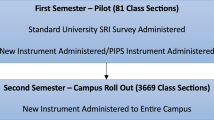Abstract
This study investigated university instructors' teaching profiles (rank order of teaching behaviors) as they emerge from student ratings. The data consisted of student ratings of all faculty members in the physics and chemistry departments at Tel Aviv University, with no exception, who taught the same undergraduate course over two consecutive years. The ratings of these instructors were taken twice a semester (at mid- and end of semester), during the two academic years of the study, using a short rating instrument. A (4 × 5) × 2 ANOVA was conducted, with time of measurement and item serving as repeated measures, and department as a grouping factor. The same procedure was used for identifying differences between pairs of measurements for each item. These pairs compared the corresponding measures of the first year versus the second year, and separately those of mid-semester versus the end of semester. Findings indicate a very high degree of stability of instructors' profiles across time of measurement and activities to improve instructor performance on weak points; no clear-cut improvement from mid- to end-of-semester ratings except for teachers who undertake special improvement activities; and differences in teaching profiles for the two academic departments.
Similar content being viewed by others
References
Belgard, M., Rosenshine, B., and Gage, N. L. (1971). Study I. Effectiveness in explaining: Evidence on its generality and correlation with pupil ratings. In I. Westbury and A. A. Bellack (eds.),Research into Classroom Processes: Recent Developments and Next Steps pp. 182–191. New York: Teachers College Press.
Berk, R. A. (1989). The construction of rating instruments for faculty evaluation.Journal of Higher Education 50(5): 650–669.
Bernardin, H. J. (1977). Behavioral expectation scales versus summated scales: A fairer comparison.Journal of Applied Psychology 62: 422–427.
Biglan, A. (1973). The characteristics of subject-matter in different academic areas.Journal of Applied Psychology 57(3): 195–203.
Borman, W. C. (1975). Effects of instructions to avoid halo error on reliability and validity of performance evaluation ratings.Journal of Applied Psychology 60: 556–560.
Centra, J. A. (1979).Determining Faculty Effectiveness: Assessing Teaching, Research, and Service for Personnel Decisions and Improvements. San Francisco: Jossey-Bass.
Feldman, K. A. (1978). Course characteristics and college students' ratings of their teachers: What we know and what we don't.Research in Higher Education 9(3): 199–242.
Feldman, K. A. (1986). The perceived instructional effectiveness of college teachers as related to their personality and attitudinal characteristic: A review and synthesis.Research in Higher Education 24(2): 139–213.
Gage, N. L., Belgard, M., Dell, D., Hiller, J., Rosenshine, B., and Unruh, W. (1971). Explorations of the teacher's effectiveness in lecturing. In I. Westbury and A. A. Bellack (eds.),Research into Classroom Processes: Recent Developments and Next Steps, pp. 182–191. New York: Teachers College Press.
Goldstein, H. (1987).Multilevel Models in Educational and Social Research. New York: Oxford University Press.
Hanges, P. J., Schneider, B., and Niles, K. (1990). Stability of performance: An interactionist perspective.Journal of Applied Psychology 75(6): 658–667.
Hativa, N. (1983). What makes mathematics lessons easy to follow, understand, and remember.College Mathematics Journal 14(5): 398–406.
Hativa, N. (1984). Good teaching of mathematics as perceived by undergraduate students.International Journal of Mathematics Education in Science and Technology 15(5): 605–615.
Hativa, N. (1985). A study of the organization and clarity of mathematics lessons.International Journal of Mathematics Education in Science and Technology 16(1): 89–99.
Hativa, N. (1995). The department-wide approach to improving faculty instruction in higher education: A qualitative evaluation.Research in Higher Education 36(4): 377–413.
Hativa, N., and Raviv, A. (1993). Using a single score for summative teacher evaluation by students.Research in Higher Education 34(5): 625–646.
Hiller, J. H., Fisher, G. A., and Kaess, W. A. (1969). A computer investigation of verbal characteristics of effective classroom lecturing.American Educational Research Journal 6(4): 661–675.
Levinson-Rose, J., and Menges, R. J. (1981). Improving college teaching: A critical review of research.Review of Educational Research 51(3): 403–434.
Marsh, H. W. (1984). Students' evaluations of university teaching: Dimensionality, reliability, validity, potential biases, and utility.Journal of Educational Psychology 76(5): 707–754.
Marsh, H. W. (1987). Students' evaluations of university teaching: Research findings, methodological issues, and directions for future research.International Journal of Educational Research 11(3): 253–388.
Marsh, H. W., and Bailey, M. (1993). Multidimensionality of students' evaluations of teaching effectiveness: A profile analysis.Journal of Higher Education 64(1): 1–18.
Marsh, H. W., and Overall, J. U. (1979). Long-term stability of students' evaluations: A note on Feldman's “Consistency and variability among college students in rating their teachers and courses.”Research in Higher Education 10(2): 139–147.
Marsh, H. W., and Overall, J. U. (1981). The relative influence of course level, course type, and instructor on students' evaluations of college teaching.American Educational Research Journal 18(1): 103–112.
Marsh, H. W., and Roche, L. (1993). The use of students' evaluations and an individually structured intervention to enhance university teaching effectiveness.American Educational Research Journal 30(1): 217–251.
McBean, E. A., and Al-Nassri, S. (1982). Questionnaire design for student measurement of teaching effectiveness.Higher Education 11(3): 273–288.
Murray, H. G., Rushton, P., and Paunonen, S. V. (1990). Teacher personality traits and student instructional ratings in six types of university courses.Journal of Educational Psychology 82(2): 250–261.
Nelsen, E. A., and Ray, W. J. (1983).Observational ratings of teaching performance: Dimensionality and stability. Paper presented at the Annual Meeting of the American Psychological Association, Los Angeles. ERIC ED 235–245.
Scriven, M. (1989). The design and use of forms for the student evaluation of teaching.Instructional Evaluation 10(1): 1–13.
Stevens, J. J., and Aleamoni, L. M. (1985). The use of evaluative feedback for instructional improvement: A longitudinal perspective.Instructional Science 13(4): 285–304.
Thorndike, E. L. (1920). A constant error in psychological ratings.Journal of Applied Psychology 25–29.
Williams, E. J. (1985). Research on teacher clarity.Teacher Education Quarterly 12(3): 33–38.
Author information
Authors and Affiliations
Rights and permissions
About this article
Cite this article
Hativa, N. University instructors' ratings profiles: Stability over time, and disciplinary differences. Res High Educ 37, 241–265 (1996). https://doi.org/10.1007/BF01730121
Received:
Issue Date:
DOI: https://doi.org/10.1007/BF01730121




